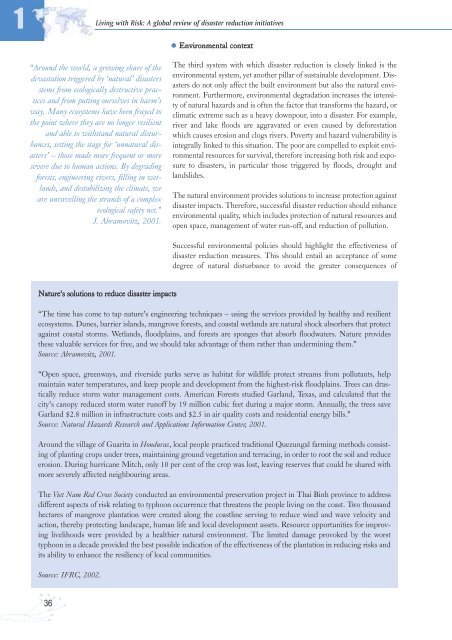A global review of disaster reduction initiatives - Welcome to the ...
A global review of disaster reduction initiatives - Welcome to the ...
A global review of disaster reduction initiatives - Welcome to the ...
Create successful ePaper yourself
Turn your PDF publications into a flip-book with our unique Google optimized e-Paper software.
1Living with Risk: A <strong>global</strong> <strong>review</strong> <strong>of</strong> <strong>disaster</strong> <strong>reduction</strong> <strong>initiatives</strong>Environmental context“Around <strong>the</strong> world, a growing share <strong>of</strong> <strong>the</strong>devastation triggered by ‘natural’ <strong>disaster</strong>sstems from ecologically destructive practicesand from putting ourselves in harm’sway. Many ecosystems have been frayed <strong>to</strong><strong>the</strong> point where <strong>the</strong>y are no longer resilientand able <strong>to</strong> withstand natural disturbances,setting <strong>the</strong> stage for ‘unnatural <strong>disaster</strong>s’– those made more frequent or moresevere due <strong>to</strong> human actions. By degradingforests, engineering rivers, filling in wetlands,and destabilizing <strong>the</strong> climate, weare unravelling <strong>the</strong> strands <strong>of</strong> a complexecological safety net.”J. Abramovitz, 2001.The third system with which <strong>disaster</strong> <strong>reduction</strong> is closely linked is <strong>the</strong>environmental system, yet ano<strong>the</strong>r pillar <strong>of</strong> sustainable development. Disastersdo not only affect <strong>the</strong> built environment but also <strong>the</strong> natural environment.Fur<strong>the</strong>rmore, environmental degradation increases <strong>the</strong> intensity<strong>of</strong> natural hazards and is <strong>of</strong>ten <strong>the</strong> fac<strong>to</strong>r that transforms <strong>the</strong> hazard, orclimatic extreme such as a heavy downpour, in<strong>to</strong> a <strong>disaster</strong>. For example,river and lake floods are aggravated or even caused by deforestationwhich causes erosion and clogs rivers. Poverty and hazard vulnerability isintegrally linked <strong>to</strong> this situation. The poor are compelled <strong>to</strong> exploit environmentalresources for survival, <strong>the</strong>refore increasing both risk and exposure<strong>to</strong> <strong>disaster</strong>s, in particular those triggered by floods, drought andlandslides.The natural environment provides solutions <strong>to</strong> increase protection against<strong>disaster</strong> impacts. Therefore, successful <strong>disaster</strong> <strong>reduction</strong> should enhanceenvironmental quality, which includes protection <strong>of</strong> natural resources andopen space, management <strong>of</strong> water run-<strong>of</strong>f, and <strong>reduction</strong> <strong>of</strong> pollution.Successful environmental policies should highlight <strong>the</strong> effectiveness <strong>of</strong><strong>disaster</strong> <strong>reduction</strong> measures. This should entail an acceptance <strong>of</strong> somedegree <strong>of</strong> natural disturbance <strong>to</strong> avoid <strong>the</strong> greater consequences <strong>of</strong>Nature’s solutions <strong>to</strong> reduce <strong>disaster</strong> impacts“The time has come <strong>to</strong> tap nature’s engineering techniques – using <strong>the</strong> services provided by healthy and resilientecosystems. Dunes, barrier islands, mangrove forests, and coastal wetlands are natural shock absorbers that protectagainst coastal s<strong>to</strong>rms. Wetlands, floodplains, and forests are sponges that absorb floodwaters. Nature provides<strong>the</strong>se valuable services for free, and we should take advantage <strong>of</strong> <strong>the</strong>m ra<strong>the</strong>r than undermining <strong>the</strong>m.”Source: Abramovitz, 2001.“Open space, greenways, and riverside parks serve as habitat for wildlife protect streams from pollutants, helpmaintain water temperatures, and keep people and development from <strong>the</strong> highest-risk floodplains. Trees can drasticallyreduce s<strong>to</strong>rm water management costs. American Forests studied Garland, Texas, and calculated that <strong>the</strong>city’s canopy reduced s<strong>to</strong>rm water run<strong>of</strong>f by 19 million cubic feet during a major s<strong>to</strong>rm. Annually, <strong>the</strong> trees saveGarland $2.8 million in infrastructure costs and $2.5 in air quality costs and residential energy bills.”Source: Natural Hazards Research and Applications Information Center, 2001.Around <strong>the</strong> village <strong>of</strong> Guarita in Honduras, local people practiced traditional Quezungal farming methods consisting<strong>of</strong> planting crops under trees, maintaining ground vegetation and terracing, in order <strong>to</strong> root <strong>the</strong> soil and reduceerosion. During hurricane Mitch, only 10 per cent <strong>of</strong> <strong>the</strong> crop was lost, leaving reserves that could be shared withmore severely affected neighbouring areas.The Viet Nam Red Cross Society conducted an environmental preservation project in Thai Binh province <strong>to</strong> addressdifferent aspects <strong>of</strong> risk relating <strong>to</strong> typhoon occurrence that threatens <strong>the</strong> people living on <strong>the</strong> coast. Two thousandhectares <strong>of</strong> mangrove plantation were created along <strong>the</strong> coastline serving <strong>to</strong> reduce wind and wave velocity andaction, <strong>the</strong>reby protecting landscape, human life and local development assets. Resource opportunities for improvinglivelihoods were provided by a healthier natural environment. The limited damage provoked by <strong>the</strong> worsttyphoon in a decade provided <strong>the</strong> best possible indication <strong>of</strong> <strong>the</strong> effectiveness <strong>of</strong> <strong>the</strong> plantation in reducing risks andits ability <strong>to</strong> enhance <strong>the</strong> resiliency <strong>of</strong> local communities.Source: IFRC, 2002.36

















